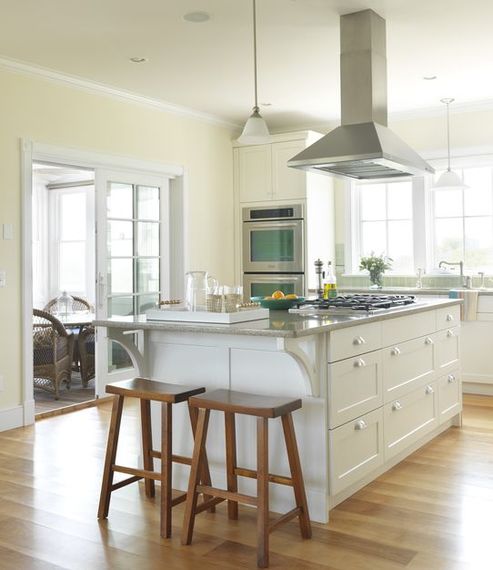Planning to remodel your kitchen? Those of us who have been there are happy to share advice. Most of these tips would apply to any remodeling project.
Take your time picking a builder, contractor or design-build firm. Interview more than one, ask many questions (and pay attention to not just the answers, but to how the answers are given), check references, listen to your gut. And then when you have a contract, read it line by line, word by word, and get all of your questions satisfactorily answered before you sign.
Expect upcharges, and build them into your budget. Some change orders will be beyond your or your builder's control (surprises discovered during demolition, requirements imposed by your municipality's architectural review board), and others you will initiate as new ideas come forth or you change your mind. (You will change your mind, most certainly more than once.)
Beware: These projects have a way of leading one to the next. As long as they were having their kitchen remodeled, Carol Moresco-Goniu and her husband, Richard Goniu, figured they might as well re-do the powder room, too. And then, the master bathroom suddenly looked ripe for a redo. Lisa Ziolkowski also replaced the front door and gave the front hallway, powder room and sun porch a facelift and had the living room and dining room repainted.
Try to stay ahead of the game. If you're told you won't have to empty your cabinets for another month, do it in two weeks.
Plan to spend lots of time online, where choices in everything from lighting fixtures to furniture and kitchen accessories are endless.
Pick what you love. Know what the trends are, but don't let them influence you unduly.
"It's important to have an idea of what you're after," said Moresco-Goniu, "but be open to suggestions."
"You've got to do a little bit of homework," advised Goniu.
Anticipate problems. You can't get discouraged. Referencing the problems they had with their cabinets, Goniu said, "Most people would get angry. I was disappointed, but we made the decision not to push (the builder) to get it done. We said, 'take your time and do it right.' If you get upset and angry, you'll have nothing but disappointment."
"Stay calm," advised Ziolkowski. "Your life is in disarray, but when it's done, it's so worth all the time and headaches."
10 decisions to consider before a kitchen remodel
Choices, choices. For some people, it's a fun opportunity; for others, a stressful chore. Given the cost of remodeling, whatever you choose — whether it's appliances, cabinet color, floor style or countertop — you'll have to live with it for a long time.So it's best to have a pretty good idea of what you want (or at least, think you want) before you begin.
Here are 10 core decisions you should think through in advance when planning to remodel your kitchen:
1. Footprint. Will you work within your kitchen's current dimensions, or do you want the room to be bigger? In which direction would you expand, and what are the ramifications for the rest of the house?
2. Cabinets (looks). Custom or prefab? Wood species, stain and glaze color, door style — all these decisions and more will need to be made.
3. Cabinets (configuration). For lower cabinets, you could do doors and shelves (pullout or stationary), or you could go with deep drawers. You probably want some of each, but how many and where? Will you have any pantries? How many and what size? Any pullout cutting boards? And how do you want to handle those pesky corners?
4. Countertops. Granite, quartz, laminate, concrete, wood or a combination. They all have their pros and cons. If going with granite, you'll need to pick a pattern, then your specific slab(s), as well as weigh in as to how the slab will be cut for the various portions of countertop in the room. All of this takes time. Take as much as you need.
5. Floor. Hardwood is still popular, but durable luxury vinyl tile, ceramic tile and bamboo are other choices to consider.
6. Appliances (if buying new). Will you replace all of them, or only one or two? Will you match the color of existing appliances or go with what you eventually want them all to be? Do you want one oven or two? There are too many choices to list here, but keep in mind some of the newer options like a small beverage fridge and a microwave-convection oven combination.
7. Placement of appliances. It can be hard to picture yourself in a whole new space cooking dinner, but it's worth making the effort. Moving the stove or fridge over a few inches could make all the difference.
8. Lighting. Pay close attention to where the can lights are placed in the ceiling. We ended up adding one directly above the sink that wasn't in the original plan and are so glad we did. Also think through where you want light switches (every doorway is a good start). Do you want dimmers? What kind of under-cabinet lighting?
9. Colors. The good news is, wall colors can easily be swapped out. Not so with tile backsplashes, lighting fixtures or other colorful features you choose.
10. Miscellaneous: How hard could it be to pick out cabinet hardware? They're just knobs and handles, after all. Answer: harder than you think. Other decisions you'll need to be ready to make include the type of sink (material, one basin or two, built-in soap dispenser or not, etc.), type of faucet and color of outlets and switchplates.
To order your copy of Remodeling Hell, CLICK HERE
For more information about Remodeling Hell, CLICK HERE
For more information about the Summit Murder Mystery series, CLICK HERE
Follow me on TWITTER
Friend me on FACEBOOK
Follow me on PINTEREST


